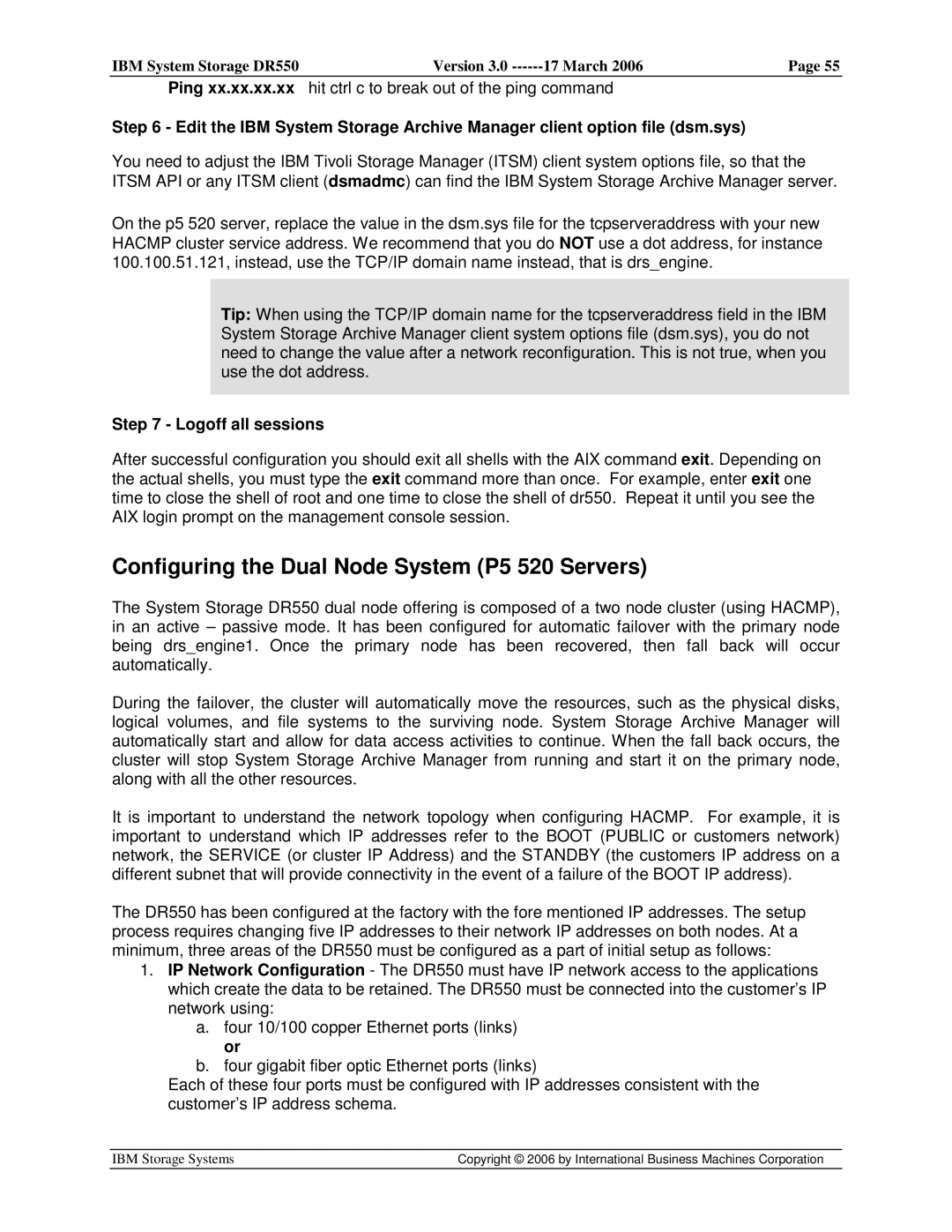
IBM System Storage DR550 | Version 3.0 | 17 March 2006 | Page 55 |
|
|
|
|
Ping xx.xx.xx.xx hit ctrl c to break out of the ping command
Step 6 - Edit the IBM System Storage Archive Manager client option file (dsm.sys)
You need to adjust the IBM Tivoli Storage Manager (ITSM) client system options file, so that the ITSM API or any ITSM client (dsmadmc) can find the IBM System Storage Archive Manager server.
On the p5 520 server, replace the value in the dsm.sys file for the tcpserveraddress with your new HACMP cluster service address. We recommend that you do NOT use a dot address, for instance 100.100.51.121, instead, use the TCP/IP domain name instead, that is drs_engine.
Tip: When using the TCP/IP domain name for the tcpserveraddress field in the IBM System Storage Archive Manager client system options file (dsm.sys), you do not need to change the value after a network reconfiguration. This is not true, when you use the dot address.
Step 7 - Logoff all sessions
After successful configuration you should exit all shells with the AIX command exit. Depending on the actual shells, you must type the exit command more than once. For example, enter exit one time to close the shell of root and one time to close the shell of dr550. Repeat it until you see the AIX login prompt on the management console session.
Configuring the Dual Node System (P5 520 Servers)
The System Storage DR550 dual node offering is composed of a two node cluster (using HACMP), in an active – passive mode. It has been configured for automatic failover with the primary node being drs_engine1. Once the primary node has been recovered, then fall back will occur automatically.
During the failover, the cluster will automatically move the resources, such as the physical disks, logical volumes, and file systems to the surviving node. System Storage Archive Manager will automatically start and allow for data access activities to continue. When the fall back occurs, the cluster will stop System Storage Archive Manager from running and start it on the primary node, along with all the other resources.
It is important to understand the network topology when configuring HACMP. For example, it is important to understand which IP addresses refer to the BOOT (PUBLIC or customers network) network, the SERVICE (or cluster IP Address) and the STANDBY (the customers IP address on a different subnet that will provide connectivity in the event of a failure of the BOOT IP address).
The DR550 has been configured at the factory with the fore mentioned IP addresses. The setup process requires changing five IP addresses to their network IP addresses on both nodes. At a minimum, three areas of the DR550 must be configured as a part of initial setup as follows:
1.IP Network Configuration - The DR550 must have IP network access to the applications which create the data to be retained. The DR550 must be connected into the customer’s IP network using:
a.four 10/100 copper Ethernet ports (links) or
b.four gigabit fiber optic Ethernet ports (links)
Each of these four ports must be configured with IP addresses consistent with the customer’s IP address schema.
IBM Storage Systems | Copyright © 2006 by International Business Machines Corporation |
|
|
